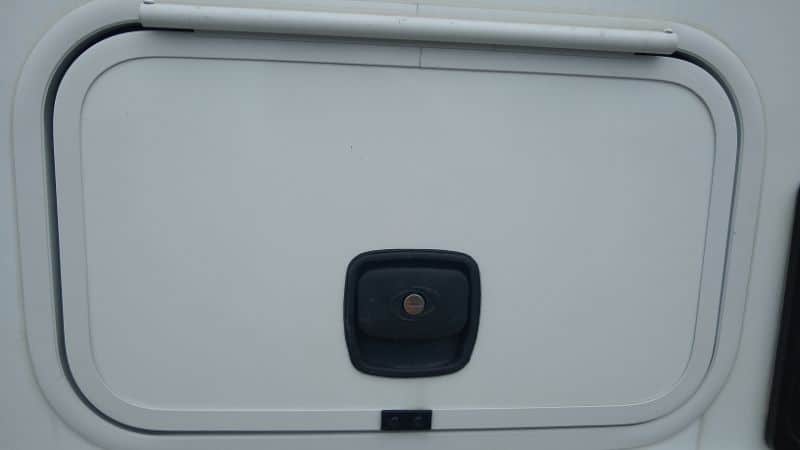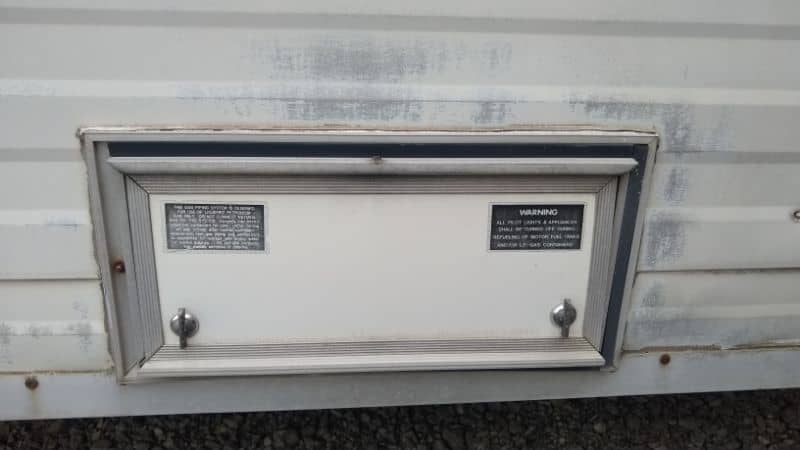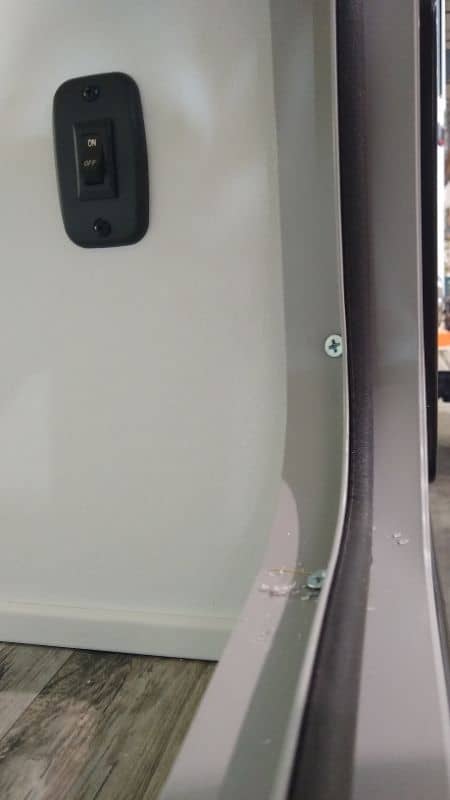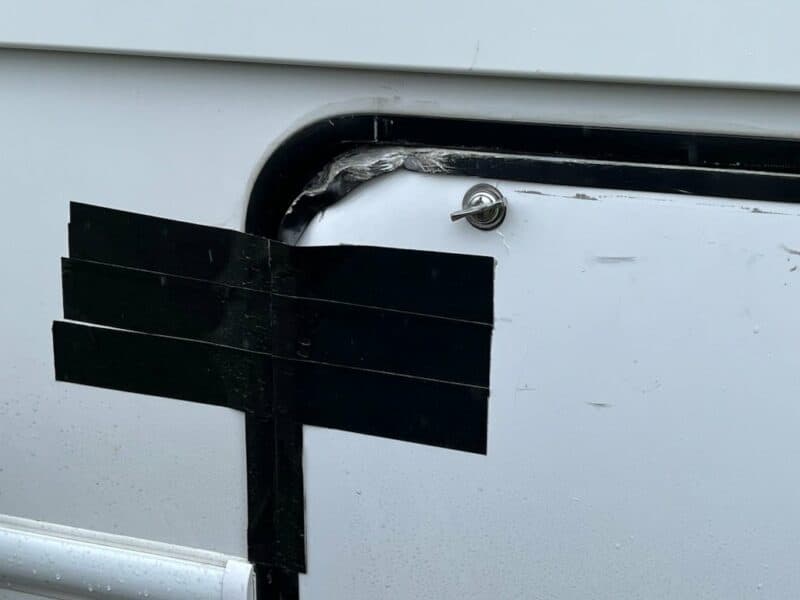RV baggage doors – also known as storage doors or cargo doors – are a common point of water leaks. Typical signs are dark water stains and spongy floors around the baggage door, sometimes as far away as the closet subfloor corner (although this could also be a roof leak!).
If you suspect a baggage door water leak, here are some tips to sleuth out and solve your leak.
Introduction to RV Baggage Door Design
Baggage doors come in two styles:
- Square corner: This style of baggage door is somewhat archaic and is now mostly used on horse trailers and cargo trailers. The rectangular frame has mitered, welded corners.
- Radius corner: This more modern style of baggage door has rolled curved corners, which allow for a seamless frame and continuous seal.


All baggage doors are made of five basic parts: main frame, door, hinge, latch, and seals. However, not all baggage doors are created equal!
- A higher-quality door will have slam latches or compression latches, heavy-duty continuous hinges, thicker door construction (1.25”-1.5”), and a gel-coat fiberglass or painted aluminum finish.
- A lower-quality door will have cam or thumb latches, piano hinges, thinner door construction (0.5-1.0”), and a PVC finish.

Baggage doors are mounted in three ways:
- Compression: The main door frame is inserted into the wall cut-out. Then a clamp ring is inserted from the inside. The two are screwed together using self-tapping screws, which compress the frame against the sidewall.
- Face-mounted: The main door frame is inserted into the wall cut-out. The main frame has an exterior flange that is screwed directly to the sidewall skin or skeleton (the screws are normally hidden by a vinyl screw cover).
- Side-mounted: The main door frame is inserted into the wall cut-out. Then the main frame is screwed into the edges of the cut-out, which have been reinforced with wood or aluminum tubing for screw retention.
Who Manufactures RV Baggage Doors?
Despite the variety of door styles, there aren’t very many RV door manufacturers.
After Lippert (technically LCI) acquired Challenger in 2020, Lippert is by far the largest manufacturer of RV baggage doors. Dexter is another major player in this industry space.
Smaller players include MNM Manufacturing, Apex Doors, All Rite, Riverside, and a few others.
Things to Know About Inspecting RV Storage Doors
- Start all baggage door inspections with a flashlight. Look for light passing through the door seal. Anywhere light can get in, so can water!
- Never assume leaks come from the top of the door. A leak can come from anywhere. Water will happily run uphill when driving down the highway at 60 mph!
- Not sure if water is getting in? Check for dirt, stains, or mold around the bottom of the door or leaks around the subfloor. Put some tissue paper beneath the compartment door and look for water stains after rainfall.
Top Causes of Water Leaks in RV Cargo Doors
Here, in no particular order, are several common causes (and fixes!) for water leaks around RV baggage doors.
Warped Baggage Door
The Problem: The baggage door itself may be warped, which creates gaps against the seals. Warping can happen from delamination, high heat, or a manufacturer’s defect. Most of these doors only have a foam core bonded to aluminum or fiberglass skins. Generally, the thicker the door, the flatter it stays.
The Fix: Warping can be a challenge to fix! Try to bend it back into shape (which may require removal from the RV).
Sagging Door
The Problem: A similar malfunction to a warped door is a sagging baggage door. Rarely seen on smaller doors, the sagging issue can occur when a door is too heavy for its hinges, or too heavy for the aluminum frame. Things bend; the door sags; the seal fails.
The Fix: A sagging door can be a challenge to fix! It often requires reinforcing the hinges with better hardware and reinforcing the subframe with stronger material, which sometimes requires a complete removal of the door.
Damaged Seal

The Problem: Most RV storage door seals aren’t particularly complicated. Most are simple D-bulb foam weatherstripping, although some use rectangular, ribbed, or Q-bulb seals. If the seal shrinks, rips, tears, or comes loose, it will not work.
Hot hint: You can check the compression against the seal by tugging on an index card or strip of paper clamped in the joint!
The Fix: If the seal is simply loose, then superglue it back into place (with a rubber-safe adhesive). If the seal is damaged, then better to replace the whole strip. You can replace it with the manufacturer’s suggested seal, but some RVers have reported success replacing the stock seal with a larger, squisher hollow Q-bulb or ribbed seal.
Loose Latch
The Problem: A loose latch won’t compress the door tightly against the frame seal. Simple quarter-turn cam latches are notorious for vibrating loose over time.
The Fix: If the door latch isn’t compressing the seal, it must be tightened. Cam latches can be adjusted by simply rotating the cam. Slam latches can be tightened by adjusting the striker plate (if equipped) or shimming the striker backstop. Pop-out latches are easiest to just replace.
Clogged Weep Holes
The Problem: Some of the larger cargo/basement doors have water drainage channels and weep holes integrated into the frame. These weep holes allow intruding water to escape back to the outside.
The Fix: Use a hook, pick, and/or compressed air to clean out the weep holes.
Leaky Gasket
The Problem: Don’t reflexively assume the water is leaking through the door seal; it might be leaking through the frame seal! The main frame is sealed against the sidewall with butyl tape, silicone sealant, or some other gasket. This gasket can become brittle and crack over time (or the RV manufacturer may not have installed it in the first place.)
The Fix: Doors with a clamp ring can be drawn tighter simply by torquing the clamp ring screws. Other types of doors may have to be removed, cleaned, and resealed. And don’t forget the cap sealant over the gasket! I like using one of these non-sag sealants here.
Are RV Cargo Door Water Leaks Covered by Warranty?
If you have a new RV, baggage door leaks should be covered under your RV Manufacturer’s Factory warranty. If you have a used RV, cargo door leaks may be covered by your aftermarket warranty or an extended service plan. But tread carefully. Most policies will deny water leaks due to “lack of maintenance,” which means if you can’t prove that you have A) checked your seals every 3 months and B) replaced your seals every 12 months, you might be denied coverage.
Leave a Reply